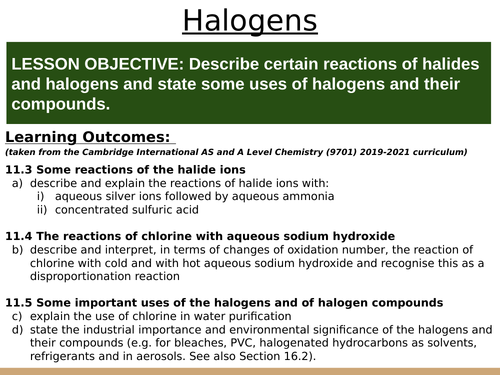


LESSON OBJECTIVE: Describe certain reactions of halides and halogens and state some uses of halogens and their compounds.
In this lesson we some reactions of the Halogens, the concept of disproportionation and discuss some of the uses of the halogens and their compounds. This is lesson seven in our inorganic chemistry series for Unit 11: Group 17 (from the Cambridge International AS Chemistry Curriculum (9701) 2019-2021 curriculum).
Learning Outcomes:
(taken from the Cambridge International AS and A Level Chemistry (9701) 2019-2021 curriculum)
11.3 Some reactions of the halide ions
a) describe and explain the reactions of halide ions with:
i) aqueous silver ions followed by aqueous ammonia
ii) concentrated sulfuric acid
11.4 The reactions of chlorine with aqueous sodium hydroxide
a) describe and interpret, in terms of changes of oxidation number, the reaction of chlorine with cold and with hot aqueous sodium hydroxide and recognise this as a disproportionation reaction
11.5 Some important uses of the halogens and of halogen compounds
a) explain the use of chlorine in water purification
b) state the industrial importance and environmental significance of the halogens and their compounds (e.g. for bleaches, PVC, halogenated hydrocarbons as solvents, refrigerants and in aerosols. See also Section 16.2).
Something went wrong, please try again later.
This resource hasn't been reviewed yet
To ensure quality for our reviews, only customers who have downloaded this resource can review it
Report this resourceto let us know if it violates our terms and conditions.
Our customer service team will review your report and will be in touch.